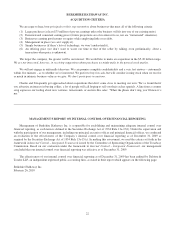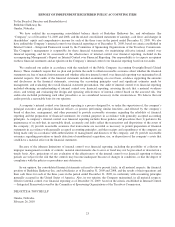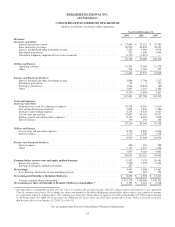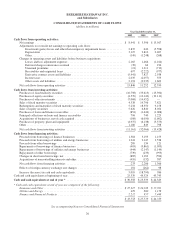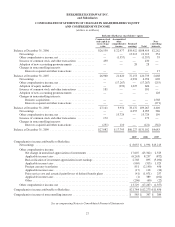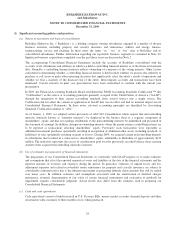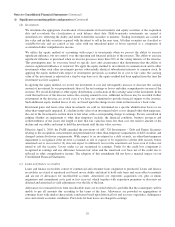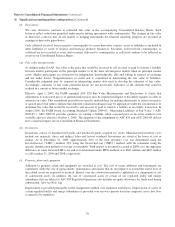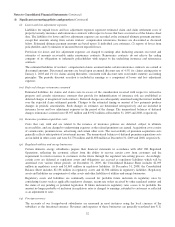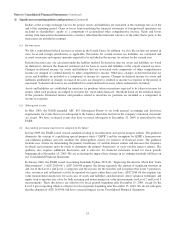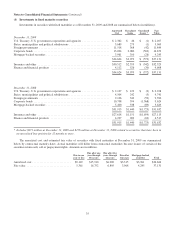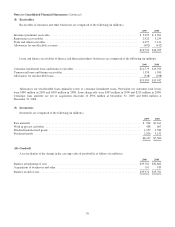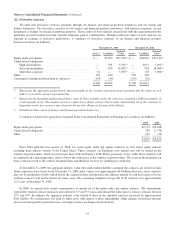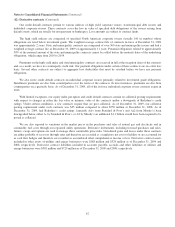Berkshire Hathaway 2009 Annual Report Download - page 34
Download and view the complete annual report
Please find page 34 of the 2009 Berkshire Hathaway annual report below. You can navigate through the pages in the report by either clicking on the pages listed below, or by using the keyword search tool below to find specific information within the annual report.Notes to Consolidated Financial Statements (Continued)
(1) Significant accounting policies and practices (Continued)
(l) Losses and loss adjustment expenses
Liabilities for unpaid losses and loss adjustment expenses represent estimated claim and claim settlement costs of
property/casualty insurance and reinsurance contracts with respect to losses that have occurred as of the balance sheet
date. The liabilities for losses and loss adjustment expenses are recorded at the estimated ultimate payment amounts,
except that amounts arising from certain workers’ compensation reinsurance business are discounted as discussed
below. Estimated ultimate payment amounts are based upon (1) individual case estimates, (2) reports of losses from
policyholders and (3) estimates of incurred but not reported losses.
Provisions for losses and loss adjustment expenses are charged to earnings after deducting amounts recovered and
estimates of amounts recoverable under reinsurance contracts. Reinsurance contracts do not relieve the ceding
company of its obligations to indemnify policyholders with respect to the underlying insurance and reinsurance
contracts.
The estimated liabilities of workers’ compensation claims assumed under certain reinsurance contracts are carried at
discounted amounts. Discounted amounts are based upon an annual discount rate of 4.5% for claims arising prior to
January 1, 2003 and 1% for claims arising thereafter, consistent with discount rates used under statutory accounting
principles. The periodic discount accretion is included in earnings as a component of losses and loss adjustment
expenses.
(m) Deferred charges reinsurance assumed
Estimated liabilities for claims and claim costs in excess of the consideration received with respect to retroactive
property and casualty reinsurance contracts that provide for indemnification of insurance risk are established as
deferred charges at inception of such contracts. Deferred charges are subsequently amortized using the interest method
over the expected claim settlement periods. Changes to the estimated timing or amount of loss payments produce
changes in periodic amortization. Such changes in estimates are determined retrospectively and are included in
insurance losses and loss adjustment expenses in the period of the change. The unamortized balances of deferred
charges reinsurance assumed were $3,957 million and $3,923 million at December 31, 2009 and 2008, respectively.
(n) Insurance premium acquisition costs
Costs that vary with and are related to the issuance of insurance policies are deferred, subject to ultimate
recoverability, and are charged to underwriting expenses as the related premiums are earned. Acquisition costs consist
of commissions, premium taxes, advertising and certain other costs. The recoverability of premium acquisition costs
generally reflects anticipation of investment income. The unamortized balances of deferred premium acquisition costs
are included in other assets and were $1,770 million and $1,698 million at December 31, 2009 and 2008, respectively.
(p) Regulated utilities and energy businesses
Certain domestic energy subsidiaries prepare their financial statements in accordance with ASC 980 Regulated
Operations, reflecting the economic effects from the ability to recover certain costs from customers and the
requirement to return revenues to customers in the future through the regulated rate-setting process. Accordingly,
certain costs are deferred as regulatory assets and obligations are accrued as regulatory liabilities which will be
amortized over various future periods. At December 31, 2009, the Consolidated Balance Sheet includes $2,093
million in regulatory assets and $1,603 million in regulatory liabilities. At December 31, 2008, the Consolidated
Balance Sheet includes $2,156 million in regulatory assets and $1,506 million in regulatory liabilities. Regulatory
assets and liabilities are components of other assets and other liabilities of utilities and energy businesses.
Regulatory assets and liabilities are continually assessed for probable future inclusion in regulatory rates by
considering factors such as applicable regulatory changes, recent rate orders received by other regulated entities and
the status of any pending or potential legislation. If future inclusion in regulatory rates ceases to be probable, the
amount no longer probable of inclusion in regulatory rates is charged to earnings, refunded to customers or reflected
as an adjustment to rates.
(q) Foreign currency
The accounts of our foreign-based subsidiaries are measured in most instances using the local currency of the
subsidiary as the functional currency. Revenues and expenses of these businesses are generally translated into U.S.
32


